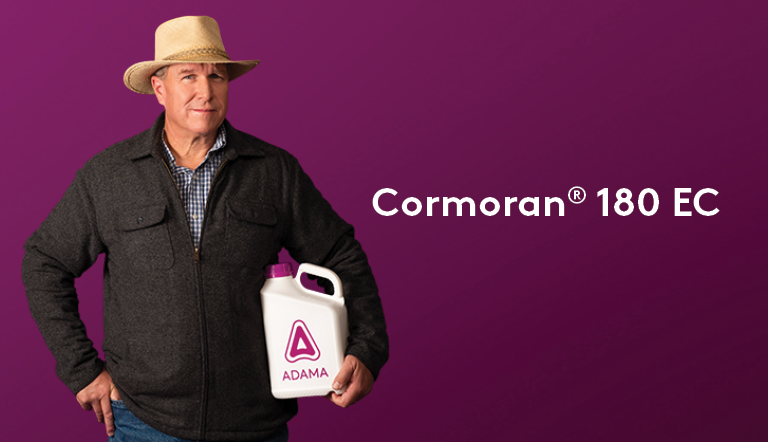
Cormoran® 180 EC Insecticide Product Overview & Infographic

Cormoran® 180 EC is an emulsifiable concentrate insecticide with a systemic, contact and stomach action, as well as chitin inhibition registered for the control of codling moth, mealy bug, African bollworm, aphids, leafhopper, tuber moth larvae, semi-looper, leaf eaters and false codling moth as indicated below.
Which crops can Cormoran® 180 EC be used on?
- Apples
- Pears
- Cotton
- Potatoes (winter rainfall region only)
- Soy beans
- Stone fruit
- Tree nuts (almonds, cashews, chestnuts, hazelnuts, macadamia nuts, pecan nuts, pistachio nuts, walnuts, Brazil nuts)
Is it safe?
Always follow the safety precautions on the label. Cormoran® 180 EC is poisonous by ingestion, contact and inhalation. Handle with care and store in a cool, dry place away from food and feedstuffs. Do not apply by air or enter the treated area before spray deposit has dried (unless wearing protective clothing).
Resistance
Cormoran® 180 EC is classified as a group code 4A and 15 insecticide. To delay insecticide resistance:
- Avoid exclusive repeated use of insecticides from the same insecticide group code.
- Alternate or tank-mix with products from different insecticide group codes.
- Integrate cultural and biological control methods into insect control programmes.
For specific information on resistance management contact your ADAMA field agent.
Which pests?
- Codling moth (Cydia pomonella) and mealy bug (various spp.) on apples and pears
- African bollworm (Helicoverpa armigera), aphids (Aphis gossypii) and leafhopper (Jacobiella fascialis) on cotton (potato aphid and green peach aphid will also be controlled)
- Tuber moth larvae (Phthorimaea operculella) on potatoes (only in winter-rainfall region)
- African bollworm (Helicoverpa armigera), semi-looper (Chrysodeixis acuta) and leaf eaters (Spodoptera spp.) on soybeans
- False codling moth (Thaumatotibia leucotreta) on stone fruit. *
- False codling moth (Thaumatotibia leucotreta) on tree nuts. *
Check the Cormoran® 180 EC label for specific agricultural practices and dosages for each crop.
NOTE: * Emergency registration has been granted for these crops. Cormoran® 180 EC still under evaluation with regard to efficacy, selectivity and behaviour of residues in these particular crops. Environmental and human safety data have already been evaluated and approved at initial registration of the product.
Mixing instructions
- Half fill the spray tank with clean water.
- Pre-mix the required quantity of Cormoran® 180 EC in a small volume of water and add to the spray tank while agitating.
- Rinse the container and add rinsate to the spray tank.
- While agitating, fill the spray tank with water to the required volume. Continue agitation during mixing and application.
NOTE: It is advisable to carry out a physical compatibility test prior to application when CORMORAN® 180 EC is tank mixed with other fungicides or insecticides.
When should Cormoran® 180 EC be applied?
In general, it is advised that Cormoran® 180 EC should be applied early in the season. The one active ingredient, novaluron, controls Lepidopteran pests and should ideally be sprayed on the eggs or first instar caterpillars. Acetamiprid, the second active ingredient in Cormoran® 180 EC, will control any sucking insects present as per the label.
Usage instructions
Avoid using Cormoran® 180 EC on plants that are under stress conditions caused by drought, nematodes and water logging conditions etc. since this will affect the systemic uptake, translocation and chemical activity of the product. Avoid spraying CORMORAN® 180 EC on plants covered with dust as dust interferes with the proper uptake of product and contact with the insect.
Consult the Cormoran® 180 EC label for comprehensive directions for use on different crops. Alternatively, contact your ADAMA field team for more information.
Cormoran® 180 EC - Active ingredients: Acetamiprid (neonicotinoids), novaluron (benzoylurea) | Registration number L9480 Act 36 of 1947 N-AR 1501 | Address of Registration holder: Simeka House, The Vineyards Office Estate, 99 Jip de Jager Drive, Belville 7530, South Africa
